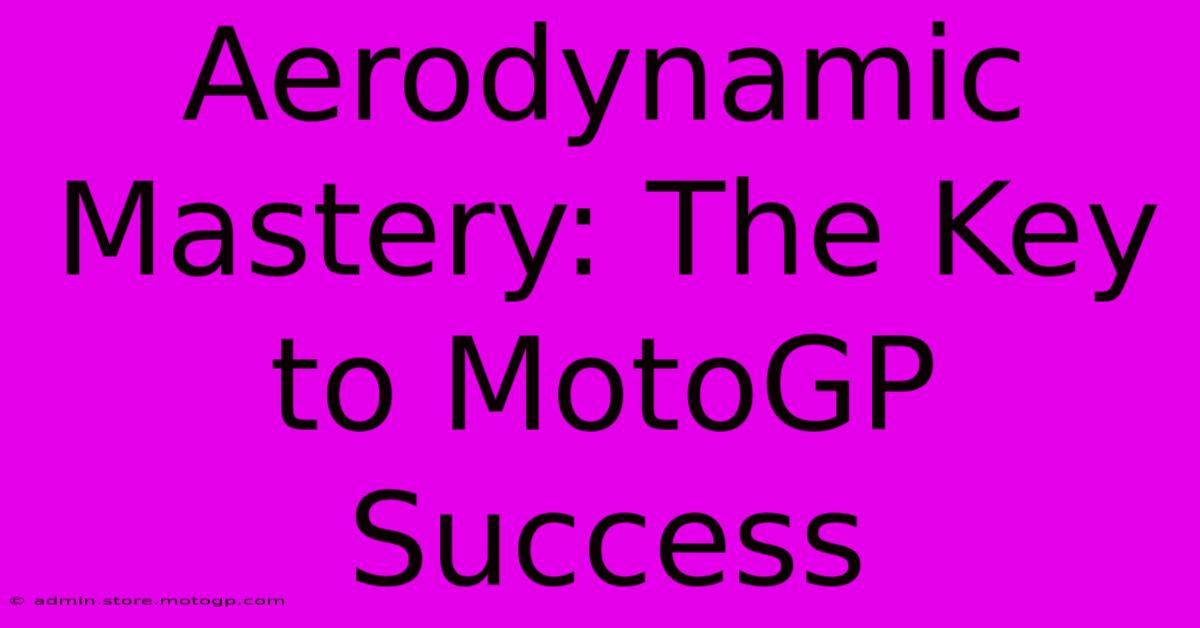Aerodynamic Mastery: The Key To MotoGP Success

Table of Contents
Aerodynamic Mastery: The Key to MotoGP Success
MotoGP, the pinnacle of motorcycle road racing, is a relentless battle for milliseconds. Every advantage, no matter how small, can be the difference between victory and defeat. While rider skill and engine power are crucial, aerodynamics has emerged as a critical, often overlooked, factor in achieving ultimate success. This article delves into the science behind aerodynamic mastery and how it's shaping the future of MotoGP.
The Science of Speed: Understanding MotoGP Aerodynamics
MotoGP bikes, traveling at speeds exceeding 200 mph (320 km/h), experience immense aerodynamic forces. These forces, primarily drag and downforce, significantly impact performance. Drag opposes the bike's motion, slowing it down, while downforce pushes the bike towards the track, improving stability and grip at high speeds.
Drag Reduction: The Pursuit of Minimal Resistance
Minimizing drag is paramount. Teams employ sophisticated Computational Fluid Dynamics (CFD) simulations and wind tunnel testing to optimize every component, from the fairing to the exhaust. Even seemingly minor changes, like the shape of a mirror or the angle of a winglet, can have a significant impact on drag. The objective is to create a streamlined profile that allows the bike to cut through the air with minimal resistance, maximizing top speed on straights.
Downforce Generation: Cornering Confidence
While reducing drag is important, generating sufficient downforce is equally crucial for cornering. High speeds through corners demand exceptional stability and grip. Modern MotoGP bikes achieve this through strategically placed aerodynamic appendages, often referred to as wings or winglets. These generate downforce, pressing the tires firmly to the track, enhancing traction and enabling riders to lean into corners with greater confidence and higher speed.
Aerodynamic Innovations in MotoGP: A Technological Arms Race
The pursuit of aerodynamic perfection is an ongoing technological arms race. Teams continually refine their designs, incorporating cutting-edge materials and manufacturing techniques. Recent innovations include:
- Sophisticated Wing Designs: The shape and placement of wings have evolved dramatically. Teams experiment with different wing configurations to optimize downforce while minimizing drag.
- Fairing Optimization: The fairing, the main bodywork of the bike, is meticulously designed to manage airflow around the rider and engine. Small changes in its shape can have a significant effect on both drag and downforce.
- Computational Fluid Dynamics (CFD): CFD simulations allow engineers to virtually test different designs before physically manufacturing them, significantly reducing development time and costs. This allows for rapid iteration and optimization.
The Rider Factor: Adapting to Aerodynamic Forces
While the engineers design and develop the aerodynamic package, the rider plays a crucial role in harnessing its potential. Riders must learn to manage the increased downforce at high speeds, adapting their riding style to optimize traction and stability. The feedback provided by riders during testing is invaluable in refining the aerodynamic performance.
The Future of Aerodynamics in MotoGP
The future of aerodynamic development in MotoGP promises to be even more exciting. We can anticipate:
- Active Aerodynamics: The use of active aerodynamic systems, capable of adjusting their shape based on speed and cornering conditions, could revolutionize performance.
- Advanced Materials: The use of lighter and stronger materials, like carbon fiber composites, will allow for more complex and efficient designs.
- Improved Simulation Techniques: Further advancements in CFD and other simulation tools will enable more precise and accurate aerodynamic optimization.
In conclusion, aerodynamic mastery is no longer a niche aspect of MotoGP; it's a critical factor determining race results. The continuous pursuit of aerodynamic efficiency, through innovation and collaboration between engineers and riders, will continue to shape the future of this thrilling motorsport. The quest for milliseconds continues, and aerodynamics is at the forefront of this ongoing battle for supremacy.

Thank you for visiting our website wich cover about Aerodynamic Mastery: The Key To MotoGP Success. We hope the information provided has been useful to you. Feel free to contact us if you have any questions or need further assistance. See you next time and dont miss to bookmark.
Featured Posts
-
The Queen Circuit An Epic American Journey
Feb 19, 2025
-
Moto Gp Helmets The Ultimate Riding Investment
Feb 19, 2025
-
Cota Transportation Explore All Your Options
Feb 19, 2025
-
The Ultimate Racing Experience Bikes For Sale Now
Feb 19, 2025
-
Moto Gp Sprint Race Results The Race That Everyones Talking About
Feb 19, 2025
